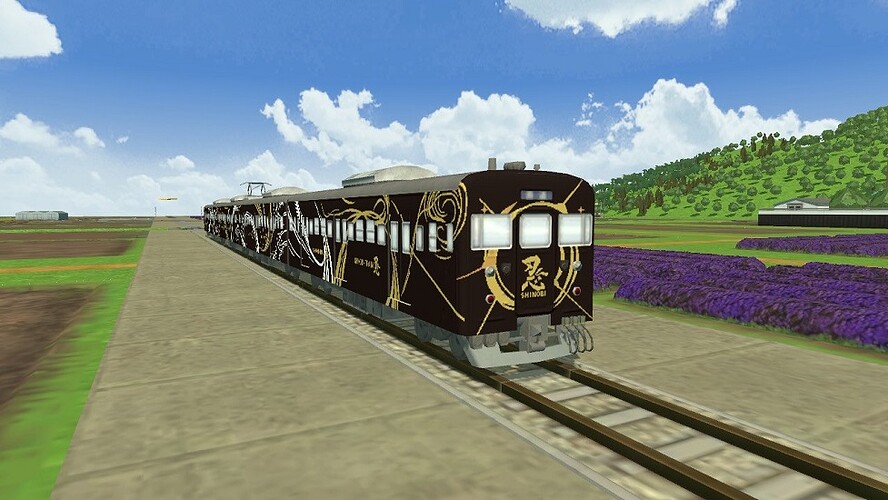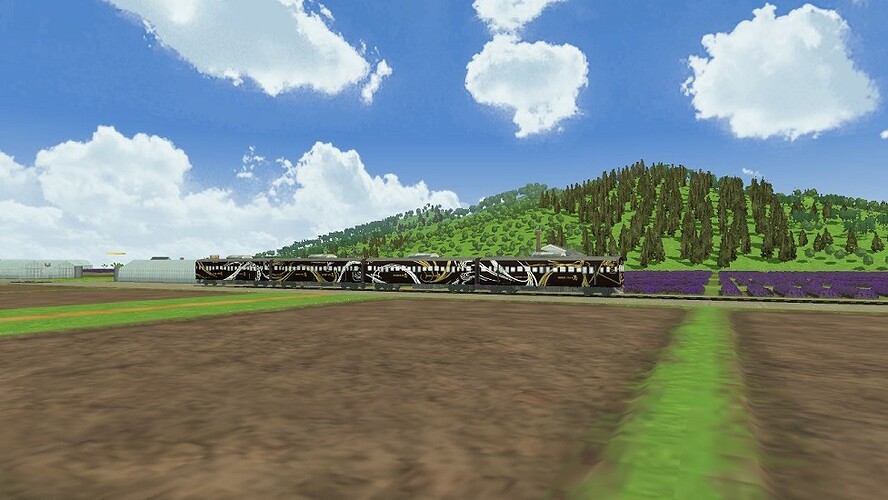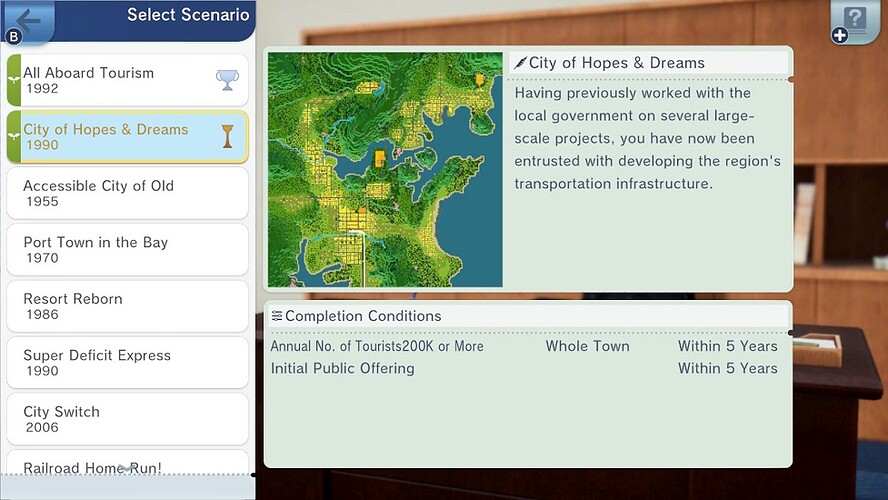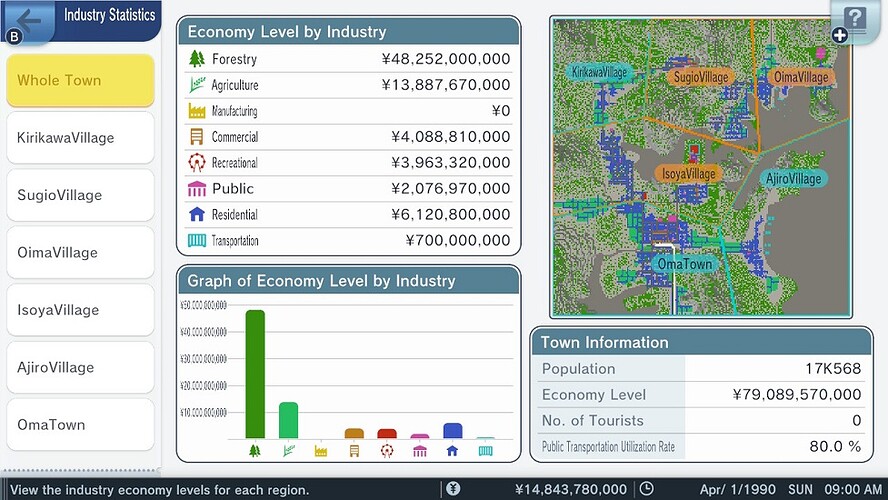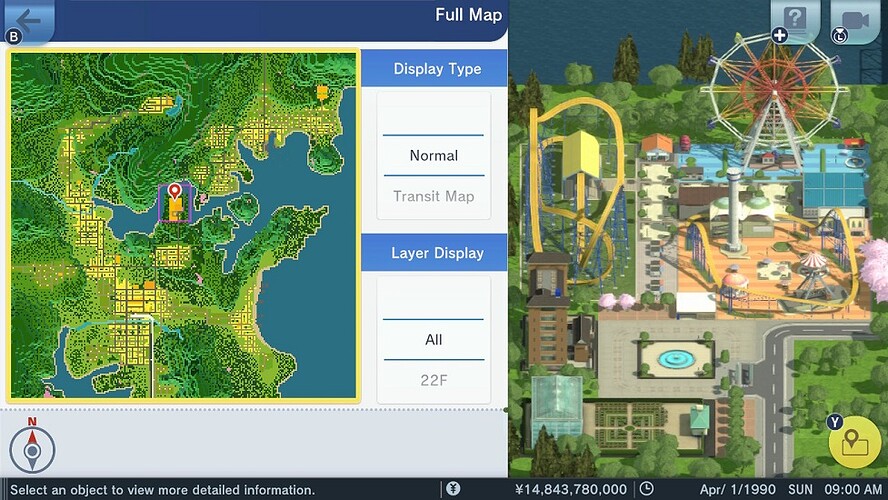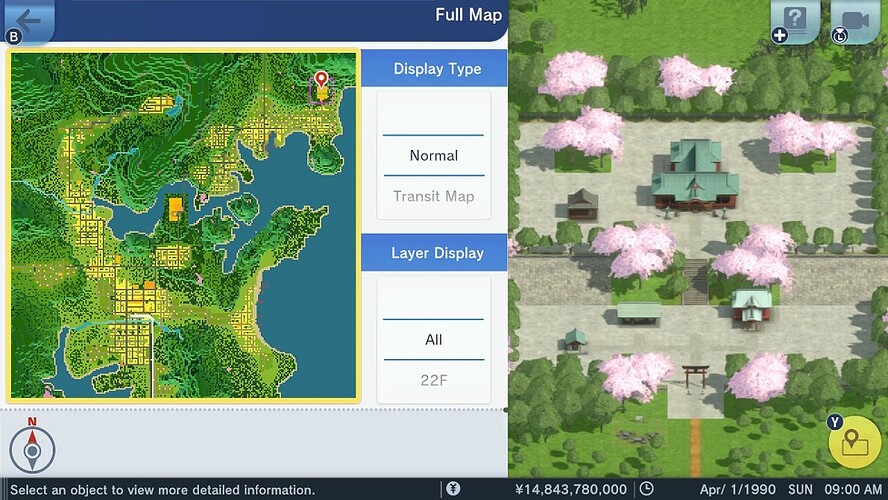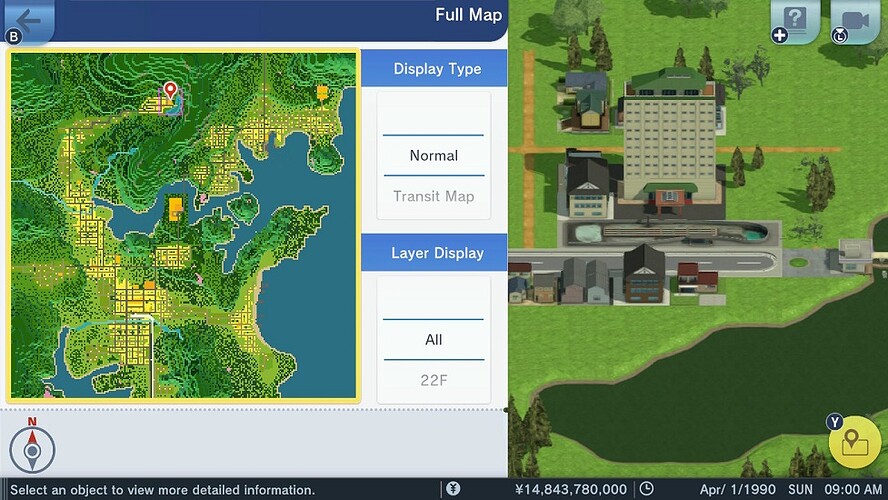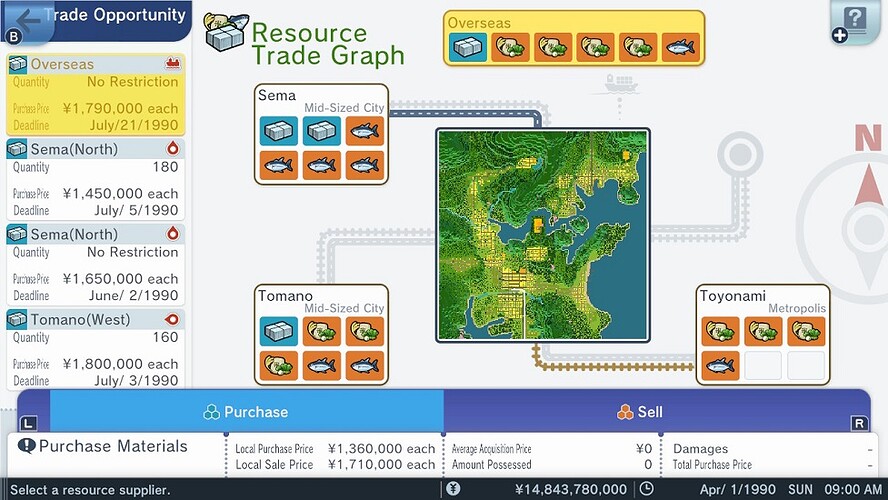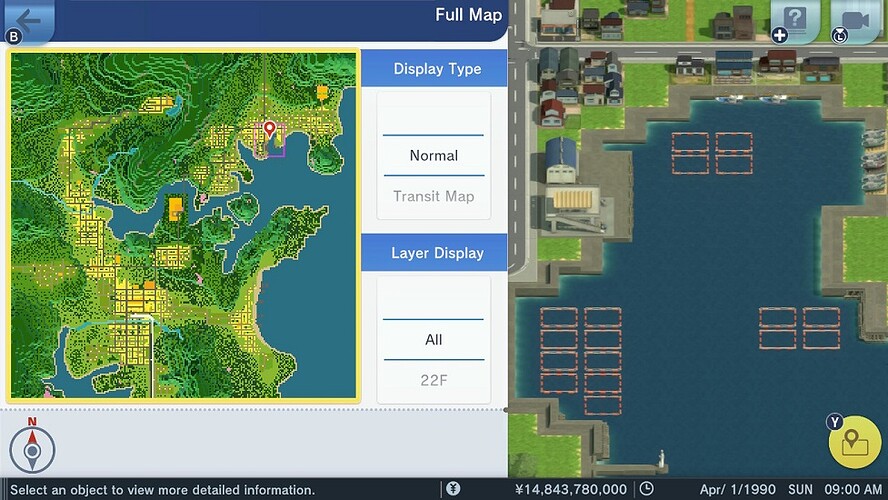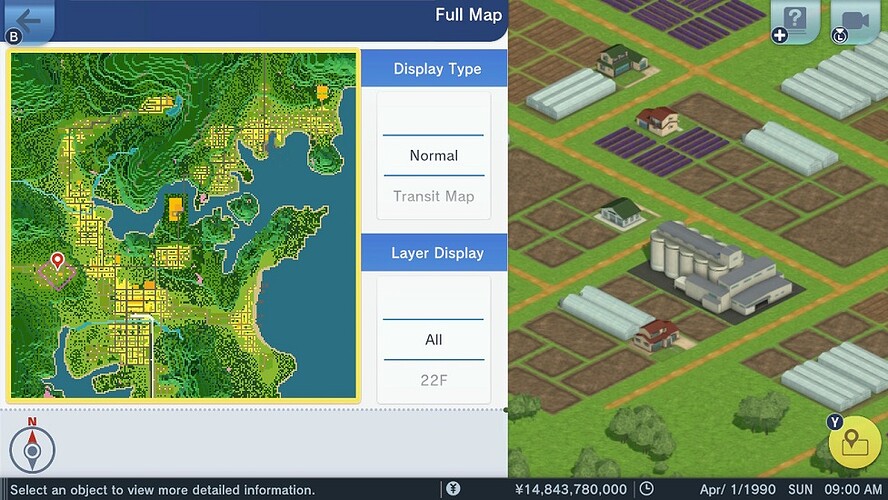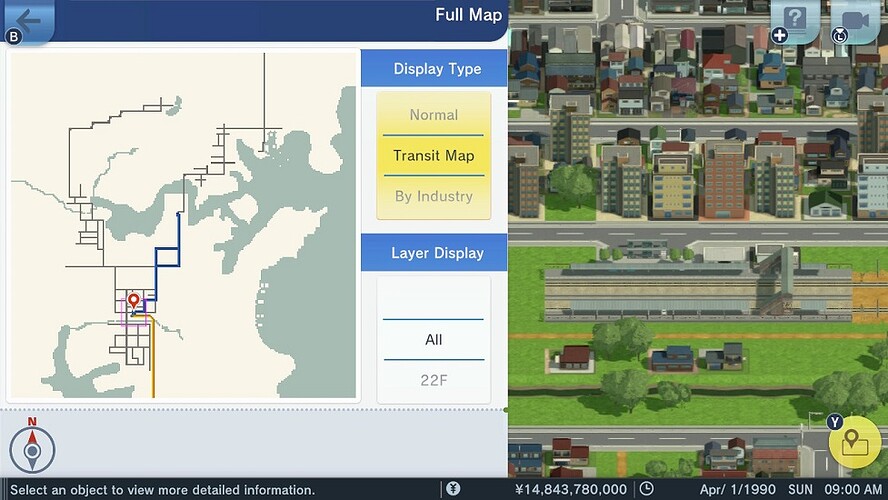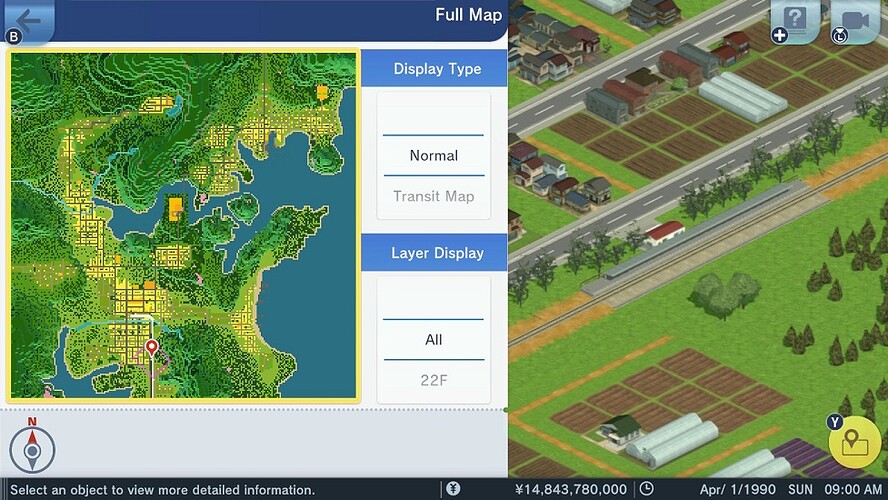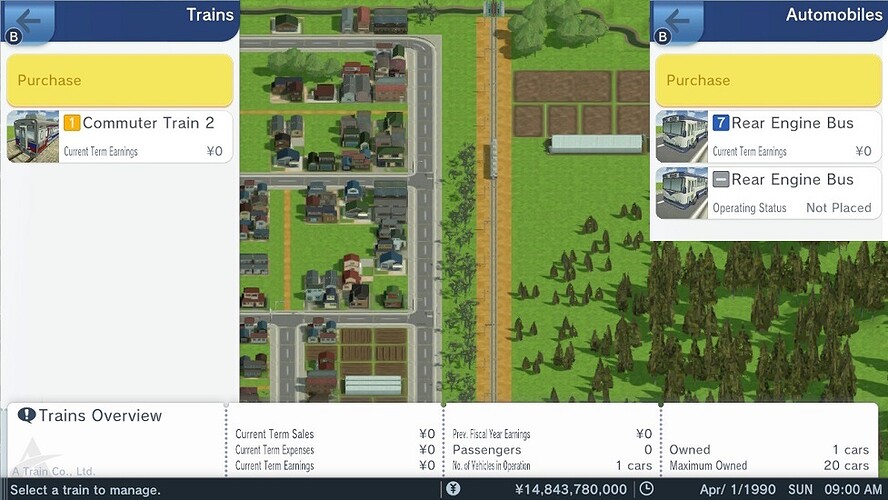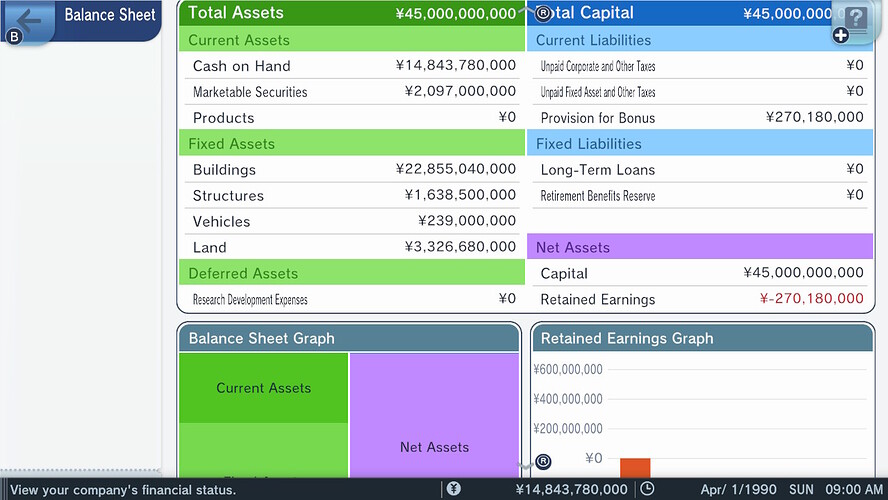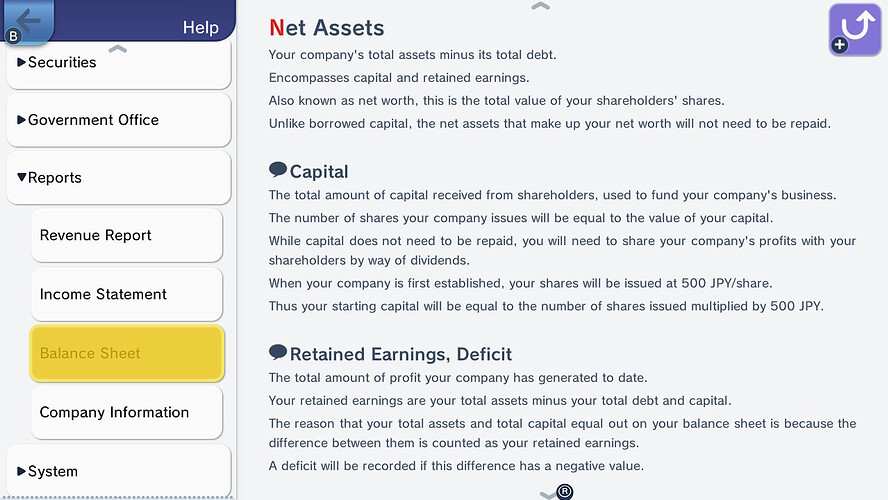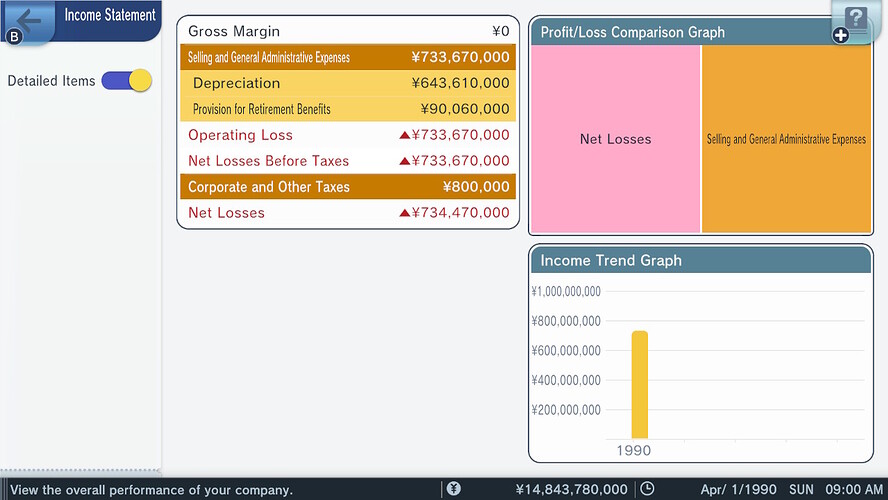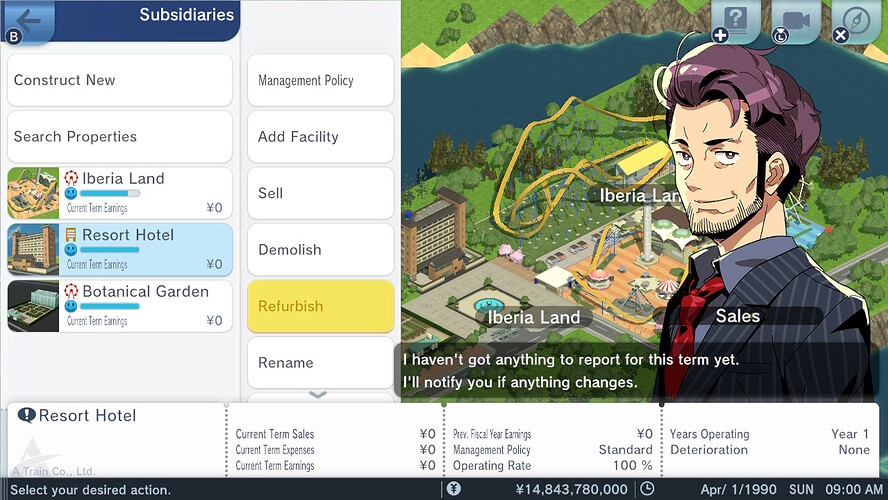So many trains, and no collisions :O
It really is one of the draws of the genre. I love, when passing time or when I’ve beaten a scenario and am simply waiting for the formal conditions to pass, just picking a train and watching it run the route in games like RRT3.
There is something to the simple pleasure of watching the trains roll by.
I can’t believe I never related this to 80s kids dreaming in front of store train displays. Seems so obvious now!
Some of the Japanese fan-made video content for the A-Train series really emphasizes that point. They love a good ol’ train ride-along and such in A-Train 9.
They even do oddly beautiful things like capture a 24-hour snapshot of a single train station. Which makes me marvel at how much work must have went into the timetabling. Plus all the work that must have went into creating the digital platform screen overlays and such.
Doesn’t matter which game in the series it is either, you can find similar content for A-Train: All Aboard! Tourism and all the way back to some of the earliest 3D A-Train games.
To say I went down a rabbit hole one day would be putting it lightly, haha. Some people really get into the vehicle customisation options and livery editor that is buried within A-Train: All Aboard! Tourism too!
(Source: Twitter)
I see something like that, or the countless recreations of real-life JR rolling stock that also exist, and gosh some people must spend hours fiddling away with the various vehicle customisation options available.
I picked up All Aboard Tourism because I appear to have entered a rather whimsical phase, and I just got to the freight tutorial, which is the first thing that had me going, “uhh” (although the tutorial about shutting off the trains for the night had me looking for and not finding a way to tell how many people ride the trains and when). Time to go back and read every post in this thread in detail.
It’s a bit hilarious that getting into your game involves no fewer than three loading screens.
You’re not supposed to quit, but put the console to sleep @_@
Once you get above the interface learning curve (which is not helped, at all, by the fact the game takes most useful toys or shortcuts away during the two tutorial scenarios, while skipping capital elements), setting up all the details of your network becomes a joy, really.
Yeah, the first two scenarios (and a custom one that I tried) lock out major functionality without any hint that it should be available later. It would almost have been easier to start in a sandbox mode game with all the toys before diving into the tutorials.
Well, that’s not really an option on a shared Switch, alas.
Well there is only one thing for it then. Time to get the household, or whatever, all addicted to some A-Train, haha. Personally, I’m running the game on the Switch’s internal storage so the load times have been pretty good for me even during game boots.
Happy to help if there is anything still unclear after reading through the thread.
Though, the basic gist is that what freight cars you add to your electric, diesel or steam locomotive control what cargo it can carry. Subsequently, the Freight tab in the Operating Route menu, within the Operating Schedule menu nestled in the Train menu, lets you decide how much of a cargo type to load or unload at a specific station. Finally, the Storage Area menu, within the Resources menu, let you build storage areas to store the cargo.
The storage facilities you typically want to build within a 20-square catchment area, which is a 5-square radius emanating in each direction from the center of the station building IIRC. Unimportant for the purposes of the tutorial but you can later adjust this catchment area when you gain access to the Advanced Settings tab and can enable the Freight Range Settings toggle.
That’s usually one of those things Artdink let the player figure out whilst playing. There’s an underlying schedule to it all that determines what hours ridership will be busiest for certain building types. For example, having a lot of residential buildings in a station catchment area means passenger demand will typically peak during 7-9am when people are commuting to their work.
Quickest way to see how many people are currently riding a train is to either select it using the cursor in the isometric view or push the ZR button, thus opening the Tracking Camera menu\view. From there you can cycle through your trains, automobiles, stations\stops, and subsidiaries using either the various categorised menus or by using the ZR button. With important information such as earnings, expenses, current passengers and the like listed at the bottom.
Putting tourists to one side for a moment, typically demand is highest during the rush hour period of either commuting to work or commuting back home. Tourists often have a fairly similar schedule though, with tourist ridership peaking around a similar time in the morning and evening.
Probably one of those things where a data layer or menu could prove useful to help elucidate these things to newer non-Japanese players. However, there are usually plenty of opportunities to relax and observe your trains during their daily schedules. So, with enough time and experience most people typically internalise the underlying schedule that determines the peak ridership (passenger supply) of each building type.
The game skews fairly closely to portraying a typical real-life day in Japan in regards to when people commute to work, commute back home from officers or industries, commute to entertainment and recreational districts, etc.
So the trains will be busy at 10pm or so, then? xD
I am still reading through the thread. “Voluminous” is probably the correct word. The freight thing had me scratching my head for a couple reasons. I saw that S. Enomori had a large materials storehouse nearby, stuffed with materials (thanks no doubt to the nearby materials factory). I saw also that Nagashirojo had a smaller but empty storehouse nearby. Seemed like a good place to start. Head scratcher #1 is that there appears to be no way to alter a train in service, even if you withdraw it? So to carry freight it was either a whole new line and train (I don’t think I have access to complicated switching yet?) or withdraw the in service train and replace it with a new one that has both passenger and freight cars. I did the latter, and the new train picked up some freight but then (head scratcher #2) it didn’t drop it off. Anywhere, ever. Just tootled around with a full freight car. There must be some way to tell it where to drop this stuff off (although it never asked where to pick up from), but I am not sure what it is, and that smarmy sales guy who said it would be such a great idea to start shifting freight around sure didn’t tell me! Maybe this is all addressed upthread; still working my way through it, as I said.
If I recall correctly, I think the peak is closer to 8pm but yes once the population is big enough I’ve had trains still pretty full even up to Midnight. That’s good ol’ Japan for ya!
Alas, such is the pitfall of making the ability to change train consists, via the Change Formation option, an advanced setting in All Aboard! Tourism. So, that becomes easier to do in the future for existing trains once enabled. Which you should figure out how to do by reading through the thread.
Full skipping ahead through the tutorial scenario is somewhat of a must indeed, once you are atop the learning curve of the game and the artificial reins set by the somewhat misled dev are holding you back.
Ahem, I hope everyone bought snacks with them.
Today’s scheduled train service leaving for City of Hopes & Dreams is about to depart the station. Please ensure you have finished boarding the train and have your tickets ready for inspection by the conductor!
Let’s Play City of Hopes & Dreams - An Introduction…
Click to reveal...
Welcome once more to A-Train: All Aboard! Tourism, where our fledgling private railway corporation is back again and ready to tackle a new assignment. Progressing down the scenario list, the time has to come to turn our attention to City of Hopes & Dreams. Where we will, once again, be assisting the local government with developing the region’s transportation infrastructure and unlocking its tourism potential. Only this time, we will have a vested interest in making sure this project is a runaway success.
Our first completion condition is to surpass 200,000 annual tourists within a period of five years, a straight forward task considering we achieved that last scenario. However, the second completion condition introduces something new to the table. To achieve success we will have to conduct an initial public offering (IPO) and launch our company on the Japanese public stock exchange. A process we will learn all about within due time.
As outlined above, we begin our latest business venture with close to 15 million Japanese Yen. The majority of the remaining scenario parameters are similar to those of the All Aboard Tourism scenario. However, the eagle-eyed among you might have noticed that we begin the City of Hopes & Dreams scenario with a three star bank confidence rating and a starting interest rate of 11.2%. Slightly more favourable starting conditions should we decide to turn to the bank to supplement our initial capital.
An overview of the region shows us that it consists of the six districts of Kirikawa, Sugio, Oima, Isoya, Ajiro and Oma. Currently has the region has a population of 17,568 people, with the majority of those people residing in the Oma township. An economic breakdown of the region by industry type informs us that forests and agriculture are currently the dominant types of land-use.
There are three tourist attractions scattered across the region in the City of Hopes & Dreams scenario. Here we can see the most important of those tourist attractions, to both the local government and our company. Part of the Sun Belt Resort project, Iberia Land in the Isoya district is composed of the Viento de Espana amustment park, a large resort hotel, and some botanical gardens. Importantly, as part of our business agreement with the local government our company we will receive a significant share of the earnings generated by Iberia Land.
Located in the north-east of the map within the Oima district, the region’s second tourist attraction is a notable religious shrine. Whilst our company does not have any vested interests in ensuring the success of this tourist attraction it could still be worth integrating into our infrastructure plans for the region. Tourists can and will visit multiple tourist attractions in a region, therefore anything which has the potential to increase tourist traffic is still a boon for our company.
Directly north of Iberia Land and nestled away within the hills is Sugio Onsen. This hot spring, within the Sugio district, is the third and final prominent tourist attraction of the region. Similar to Oima Shrine, our company currently has no vested interests in Sugio Onsen. However, incorporating this notable destination into our company’s infrastructure plans could prove to be a wonderful idea.
Switching over to an overview of the region’s resources and trade opportunities, we can see that the region specialises in the production of fish and agricultural products. Meanwhile, any construction materials will have to be procured from abroad and transported into the region. Transportation connections are currently established with the mid-sized city of Sema by road and the metropolis of Toyonami by rail.
In the future our company could invest in establishing connections with the mid-sized city of Tomano to the west and with overseas destinations via the construction of a trade port.
Located within the village that lends Oima district its name is this fishing harbour. Currently, the fishery produces 10 arbitrary units of fish a day. Which our company could, depending on the trade contracts offered, choose to export out of the region to one of the three nearby cities or oversea via a trade port. At the outset of the scenario the mid-sized city of Sema, to our north, offers the easiest opportunity to begin generating revenue hauling resources.
The agricultural cooperative of Isoya district can be found close to the eastern edge of the region. At the beginning of the scenario the cooperative produces 10 agricultural products a day. Due to demand for agricultural products in the mid-sized city of Tomano to our east, constructing a road or rail connection could be a profitable venture due to the close proximity of the agricultural cooperative to the map border.
Moving on to the region’s transportation infrastructure, the local government has transferred control of all preexisting infrastructure to us. The epicenter of all transportation within the region is currently Oma Station and the associated bus stop. As illustrated by the Transit Map display mode, a rail service connects Oma Station to the metropolis of Toyonami to our south. Meanwhile, a bus route presently allows tourists to travel to Iberia Land upon reaching Oma Station.
Following the single-track railway to Toyonami we can also find Omayama Station. This small station serves the local populace and allows them to commute either into the urban center of Oma township or into the metropolis of Toyonami. Our company’s advisors expect the local vicinity to undergo a transformation over time and become more heavily urbanised. Thus, this station could potentially become quite busy in a year or two’s time.
Finally, to round things off, we will examine our company’s existing rolling stock and automobiles. Our begins the scenario with one two-car train of the Commuter Train 2 designation and two buses of the Rear Engine Bus designation. Currently, out of our total of three owned vehicles two are deployed and in operation whilst the third, our second rear engine bus, is sitting in storage awaiting deployment.
That wraps up this introduction to Let’s Play City of Hopes & Dreams. I hope you will join me next time as we begin discussing our potential business plans for the region. Until the next time we met aboard the A-Train, I hope you have a safe and wonderful journey. Sayōnara!
I just looked for this and couldn’t find it. Is this one of those things that only unlocks after a set event in the tutorial scenarios?
I believe so, yeah.
It is one of the stupidest aspects of the game, yes.
Roger. I can dig that they don’t want people to get overwhelmed, but hiding an advanced setting seems a little over the top.
It’s pretty mindboggling, but not unlike the Japanese frame of mind, to take away basic functions that somebody in the company deemed advanced, sadly.
Plans to do a short update to reboot proceedings, still ends up playing and writing for several hours…
Guess who is back with a brand new installment of quirky, charming Japanese railway business management. Life and pneumonia might have kept me either busy or knocked me down for a while but now I am back to suck more people into this wonderful game, bwahaha. Seriously though, 75+ hours of accrued playtime and still loving it.
Today’s scheduled train service leaving for City of Hopes & Dreams is about to depart the station. Please ensure you have finished boarding the train and have your tickets ready for inspection by the conductor!
Let’s Play City of Hopes & Dreams - A new challenge approaches…
Click to reveal...
Welcome back to A-Train: All Aboard! Tourism and the City of Hopes & Dreams scenario. On today’s agenda is discussing the ‘Initial Public Offering’ completion condition. This is a completion condition which we have yet to encounter and which is slowly introduced to players during the City of Hopes & Dreams scenario, which acts as the game’s second tutorial scenario when played on Easy difficulty. So, strap yourselves in because we are about to get all “accountant speak” up in here!
Broadly speaking, an Initial Public Offering (IPO) occurs when our private corporation begins selling our company’s stock on the public stock exchange. Which can also be referred to as a stock listing, since we will be listing our company on the stock exchange. Conducting an IPO can be an excellent way of unlocking additional capital, since any shares sold to the public during the IPO bolsters our company’s coffers. However, listing our company on the stock exchange does not come without its own unique risks and potential disadvantages.
Conducting an IPO occurs through the ‘Plans’ menu and will occupy a project slot whilst it is being executed by our company’s sales department. Importantly, at the beginning of the scenario we only have one project slot. However, if we enact the ‘Sales Department Expansion’ plan it grants us a second project slot and the ability to execute two plans in parallel. Thus, conducting an IPO can come with potential opportunity costs, as it will be 120 days that could have been allocated to executing other plans.
However, before our company can even begin to contemplate conducting an IPO we must first meet several key criteria. The first of those criteria relates to the current total value of our company’s net assets, which must be worth at least 9,500,000,000 Japanese Yen. Thankfully, this is something that we have already achieved. Our second criteria relates to something called Retained Earnings, which we will broach in detail later, and which must be at least 1,900,000,000 Japanese Yen. Finally, our third criteria requires the company to achieve a surplus for at least two consecutive financial years, prior to us instigating the IPO.
Determining our company’s Retained Earnings is as simple as consulting the Balance Sheet screen within the Reports menu. At the beginning of the City of Hopes & Dreams scenario we can see that currently our Retained Earnings are forecast to be in the negative, a loss of 270,180,000 Japanese Yen. This negative Retained Earnings value, or Retained Deficit if you would rather think of it like that, is due to the employee bonuses that will be paid on July 25th and December 25th of the current (financial) year. Therefore, we can expect our Retained Earnings to become positive by the end of the current financial year, as we are planning to achieve a surplus during the company’s first year of operation.
So, what are Retained Earnings I hear you ask? Well the in-game manual defines it as such:
Which is probably the best explanation that I can give since I am in no way at all a professional accountant. In layman’s terms, operating at a surplus will improve the value of our Retained Earnings or Retained Deficit whilst running at a loss will worsen it. The easiest way to ensure that our company’s Retained Earnings grow year-upon-year is to constantly achieve a profit at the end of each financial year.
At the beginning of the City of Hopes & Dreams scenario we are forecast to achieve a net loss of 734,470,000 Japanese Yen for the financial year. The bulk of this current predicted financial loss is asset depreciation, which according to my understanding spreads the cost of a tangible or physical asset over its useful or expected lifespan. It also includes the loss in fair value that assets typically experience as they age, because yes the game does indeed model our assets (i.e., buildings and vehicles) deteriorating over time.
Opening the subsidiaries menu and examining each of our existing subsidiaries we discover that Iberia Land, the Resort Hotel, and our Botanical Garden begin the scenario with no deterioration. Thus, these subsidiaries have a long expected, or useful, lifespan ahead of them. However, as the deterioration status of a subsidiary increases with the passing of time, typically over the course of years, it adversely impacts the sales revenue of the subsidiary. Fortunately, old and dilapidated subsidiaries can be refurbished to bring their premises back to being “just like new”. Which in game terms means the deterioration status of the subsidiary is reset. Amazing what a fresh coat of paint can do for sales revenues!
Obviously, with a prudent business strategy our company’s financial forecast should eventually change from a predicted loss into a predicted profit. Thus, we expect to see this forecast gradually change over the duration of the financial year as our company begins generating revenue from a combination of existing and new revenue streams. Certainly, our company’s aim heading into our first year of operation is to invest in such a way that our total revenues exceed our total costs, in spite of the massive amounts of capital we plan to invest into the region.
Alas, that concludes part two of Let’s Play City of Hopes & Dreams and our initial look into the ‘Initial Public Offering’ completion condition. When our company is closer to conducting an IPO we will examine the factors, such as our company’s credit rating, which influence how much public capital our IPO raises. Next time though we will begin outlining our business strategy and, if time so permits, begin putting it into action. So, until the we next meet aboard the A-Train, I hope you have a safe and wonderful journey!
Yeah, it is available from the second scenario onwards. Though, since the Advanced Settings are global rather than scenario or save-based, several of the advanced settings work inside the first tutorial scenario once enabled elsewhere. So, more like hidden from being accessed during the first tutorial rather than them not functioning at all.
Though, how the developers arrived at what is deemed an “advanced setting” is curious at times. Some of the options locked away were available right from the get go in A-Train 3D // A-Train PC Classic. Would have considered the “Change Formation” function a pretty important basic gameplay feature personally.



